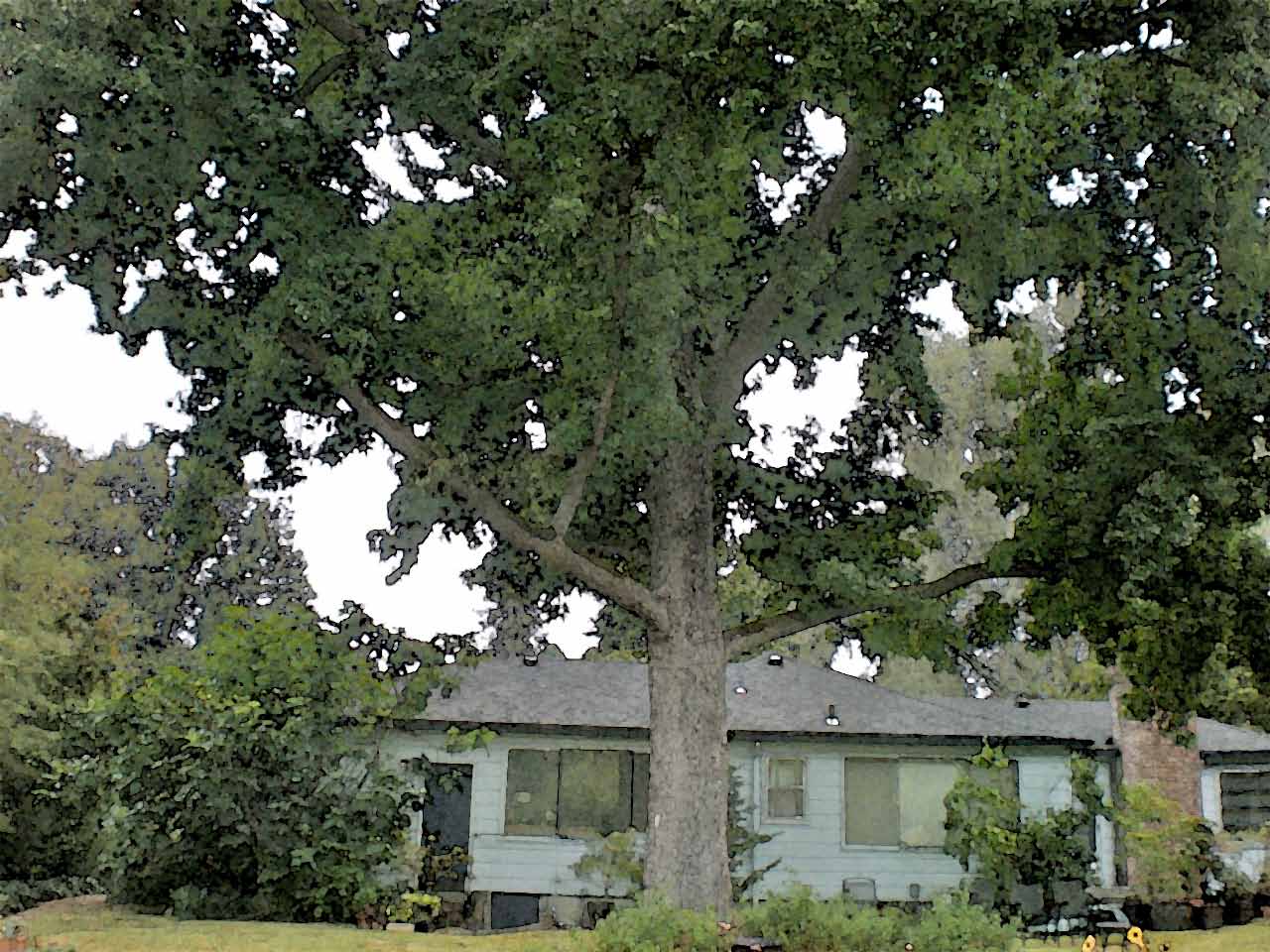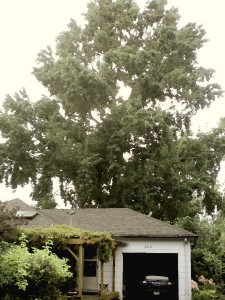

Contributor
- Topics: Archive

On a hot afternoon late last summer, my neighbor Doug and I sat peacefully in the shade of my sweetgum tree (Liquidambar styraciflua), taking a break from pruning a big willow. Doug is as crazy about gardening as I am, and the path between our gardens is well traveled.
At first we heard little pings.
“Must be those spiny fruit falling off the sweetgum and hitting the greenhouse roof,” I said. “But it’s awfully early in the season.”
A cracking sound like a rifle followed, as a huge limb dropped to the ground with a thundering thud, landing ten feet away from where we sat. We jumped to our feet. Branches and leaves quivered while more seed pods fell like hail.
“Oh my God!” I yelled. “If we’d been sitting a little closer we’d have been killed.” I began laughing hysterically from the shock. Doug laughed too, and then he went for his chain saw.
“Let me cut that up and get the wood out of the way.”
“No, you’ve done enough today. I’ll hire help tomorrow.”
“I like to help,” he insisted. “Get used to it.”
So with his chain saw and my long-handled loppers, we cut up the limb. While Doug stacked the larger pieces into a tidy pile, I hauled branches to the yard debris can. My heart sank when I saw that a dwarf ginkgo had been crushed beneath the massive limb and a favorite ceramic pot was wrecked.
I told myself it was a freak event, the result of the driest summer in Oregon’s history. Typically, the old sweetgum shed small branches in October’s winds, but never before had it dropped an entire limb.

Only a few days later another limb, even heavier than the first, crashed down—this time demolishing a bird bath. In a panic, I called several
arborists to look at the tree and advise me.
[pullquote]”My tranquil garden had suddenly become a danger zone.”[/pullquote]
That night I could hardly sleep. I pictured the garden without the tree’s sheltering shade. My favorite naughty hostas, ‘Hanky Panky’, ‘Strip Tease’, and ‘Illicit Affair’ would fry in the afternoon sun. The lacecap hydrangeas would burn to a crisp and there’d be nowhere cool and comfortable to sit and look out on the vista. Blazing sunlight from the south and west would turn my office into an oven.
Maybe skillful pruning would take the weight off the sweetgum. It would have to! But what if another limb snapped off the trunk? What if the whole tree fell and took out the greenhouse? My mind spun like a cyclone, straining to figure out a solution.
The next day, out in the garden amidst the havoc, I was terrified to walk anywhere near the tree. Every little sound scared me. My tranquil garden had suddenly become a danger zone.
After the arborists stopped by and made their recommendations, I talked things over with Doug.
“I’m so torn. One guy said it would be a crime to take the tree down, and offered to prune it. Another one said he could take it down and lift it over the house with a crane!”
“You’re kidding,” Doug said. “And when it fell on the house…”
“The last guy said if it were his tree, he’d replace it with a better tree,” I said. “He said it’s nearly to the end of its life—sweetgums live about
70 years, and this tree is about there.”
“Boy, it’s a tough decision, even if the tree is old.”
“He said it was my tree and I had to do what I felt was best. Then he said, ‘Think of it this way: the tree has done a very good job for many years, and now it’s time to let it go.’ That really made sense, and also seemed very kind.”
We sat there quietly, a safe distance from the tree.
“I’m still mulling. It’ll break my heart to take it out, but it feels too dangerous to keep it,” I said.
“I think that’s the most important part,” Doug said. “Of all places, we should be able to feel safe in our
own gardens.”
That afternoon as I sat in my office writing, I was startled by another ominous crack and the thunk of another limb hitting the ground.
“That’s it!” I told myself. “I can’t live with fear any more. The tree has to go.”
A huge wave swept over me, a combination of despair and relief, as I contemplated the loss of the precious shade I’d taken for granted for 25 years. The truth is I loved, hated, and feared the tree in equal measures. I enjoyed sitting below its canopy on summer afternoons, and appreciated how it sheltered my ferns and astilbes, as red-headed flickers pecked at its trunk and squirrels chattered from its branches. Yet I hated raking up the spiny fruit and endless blanket of leaves from October through February. Pulling up in the driveway and seeing the huge tree looming over the house, I often worried it might topple during one of our winter storms.

In the end, in ninety-degree heat, four men worked together to take down the old tree. On the first morning I watched the crew leader climb the tree, hollering directions to his helpers on the ground. His chain saw screamed and slabs of wood hammered the ground. My garden was a battlefield. Finally, I left and drove off to the library.
When I returned that afternoon, the tree had been stripped of its limbs. Only the thick telephone pole-like trunk remained. Huge rounds of wood lay in piles all over the lawn, waiting to be hauled away. The landscape looked as barren as a logging site.
The next day two men moved the wood to the driveway with an industrial hand truck, then lifted the massive slabs with a crane and dropped them into a dump truck. Earsplitting thuds echoed through the garden. They returned with a stump grinder to finish the job.
Afterward, the now-quiet backyard looked forlorn. Where the tree had once cast its soothing shade, a mountain of wood chips stood in the blinding sunlight. Confused squirrels scurried across the emptiness looking for the tree they’d scampered up and down, chasing each other in spirals along the enormous trunk. I kept the office blinds closed, unable to face the devastation.

In the weeks that followed I felt heavy-hearted. I couldn’t stop talking about the tree to everyone who would listen. I was mourning a beloved friend.
“I lost a tree too. It’s like a death in the family,” one friend said.
“Yes, that’s it exactly, you really understand!” I said. He gave me a big hug. That night, for the first time, the tears came.
It took weeks, but eventually I looked forward. I dreamt of a shady sitting space beneath a pergola covered with clematis. I looked at shade trees in neighborhoods, at nurseries and garden centers, and hiked the trails of Hoyt Arboretum with friends to study trees in maturity. In the end, Japanese zelkova (Zelkova serrata) won me over—its small leaves cast dappled light and its trunk turns the color of cinnamon. In October I laid out a new island bed for sun-loving perennials and prepared the site with fresh topsoil layered on top of damp newspaper and cardboard to smother the underlying turf. I let the soil settle before planting heat-loving penstemon, salvia, and agapanthus which I’d gathered with wild abandon during the past months to console myself throughout this difficult process.

I kept a big chunk of sweetgum wood to honor the old tree. I picture it becoming a sign saying Welcome to My Garden. Wood chips from the sweetgum’s branches are now mulching all the beds and paths, so that even in death, my old friend continues to nourish the garden.
Share:
Social Media
Garden Futurist Podcast
Most Popular
Videos
Topics
Related Posts

Ground Up Science for Greener Cities with Garden Futurist Dr. Alessandro Ossola
Spring 2023 Listen to the Podcast here. Alessandro Ossola is a scientist who gets very excited about the challenge of climate change allowing for an

Readying Urban Forests for Climate Realities with Garden Futurist Dr. Greg McPherson
Winter 2023 Listen to the Podcast here. “Going from the mow and blow to a more horticulturally knowledgeable approach to maintaining the landscape. And that

Welcome, Greywater, to the Garden
Summer 2022 Oh, summer: delightful warm air, tomatoes swelling on the vine, fragrant blooms on an evening stroll. When it’s warm and rainless, how is

Big Tree-Data and Big-Tree Data with Garden Futurist Matt Ritter
Summer 2022 Listen to the full Garden Futurist: Episode XV podcast here. We are in an environmental crisis right now in many parts of California









Responses